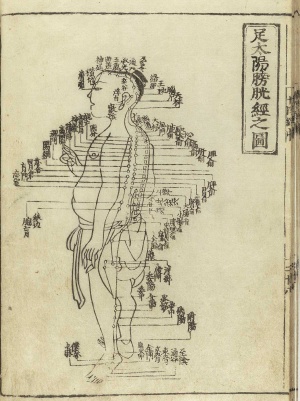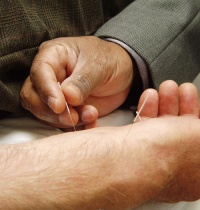Acupuncture
Original Editor - Admin - Rachael Lowe
Top Contributors - Admin, Kim Jackson, Kalyani Yajnanarayan, Vanessa Rhule, Naomi O'Reilly, Chelsea Mclene, Laura Ritchie, WikiSysop, Evan Thomas, George Prudden and Carl Clarkson
Traditional Chinese Medicine[edit | edit source]
Acupuncture forms part of traditional Chinese medicine (TCM). This ancient system of medicine dates back as far as 1000 years BC and is based on a holistic concept of treatment which regards ill health as a manifestation of imbalance in the body’s energy. Re-establishing a correct balance is the aim of TCM. Energy is referred to as Qi, (pronounced chee) and is described in terms of Yin energy – quiet and calm and Yang energy –vigorous and exciting. They are complementary opposites and in health exist in a dynamic but balanced state in the body. Practitioners of TCM believe that stimulating certain Acupuncture points on the body can help to restore the balance between Yin and Yang that becomes disturbed in illness.
Acupuncture and Physiotherapy[edit | edit source]
Acupuncture is a modality that is now being used in Western medicine to treat pain and is one of the many skills employed within physiotherapy as part of an integrated approach to the management of pain and inflammation. Physiotherapists have been using acupuncture for almost 40 years [1] and are the largest providers of acupuncture within the NHS[2]. Physiotherapists base their treatments on scientific research and clinical evidence and although there are many research studies undertaken on acupuncture they do not provide solid evidence. The studies often use small numbers and in some cases use animal subjects; it is also difficult to provide sham acupuncture resulting in flawed or ambiguous results. Therefore quite often the efficacy and reliability of acupuncture has been anecdotal and experiential. Although many theories have been put forward about how acupuncture works, there is still no definitive agreement or clear scientific explanation. There have been studies where the existence of Meridians has been investigated [3] but this still does not explain why it is effective in treating many conditions or the traditional Chinese explanation of how it works - based on yin and yang and the five elements. There are studies that claim acupuncture is a placebo whilst others set out to prove not only it’s value but offer scientific theories. One such theory is based on the pain gate theory first suggested by Melzack and Wall in 1965. Early studies have shown that acupuncture and Transcutaneous Nerve Stimulation are equally effective at relieving low back pain[4] indicating that Acupuncture can reduce pain by stimulating the brain and spinal cord[5] . More recent studies support this theory and have shown that acupuncture produces natural pain-relieving chemicals such as melatonin and serotonin which can influence sleep and feelings of well-being[6][7]. Somle sources and research studies also claim that acupuncture releases endorphins, however many of the studies, that are used as examples to support this theory, use Electro-acupuncture and a recent review of the literature concludes that there is no evidence supporting the claim that acupuncture alone releases endorphins, although it does acknowledge that endogenous opioids are released but dependent on the acupuncture dosage[8]. Based on these findings and knowledge that these chemicals assist the body's healing processes and offer pain relief it makes sense to include acupuncture prior to other treatments such as manual therapy or exercise in order to aid further recovery.
There are several techniques for applying acupuncture and these are described below:
Conventional Acupuncture[edit | edit source]
Conventional acupuncture involves the use of single-use, pre-sterilised disposable needles of varying widths, lengths and materials that pierce the skin at the acupuncture points. The physiotherapist will determine the locations of these points on the basis of an assessment of the cause of the imbalance. A number of needles may be used during each treatment, and these are typically left in position for between 20 and 30 minutes before being removed.
Trigger point acupuncture may also be used to facilitate relaxation in specific muscles following traumas, for longer-term unresolved muscle pain, or as a means of increasing muscle length in order to aid stretch and rehabilitation. In the latter case, the needle is inserted into the affected muscle until the tissue is felt to relax under the needle, which is then removed. Trigger point needling often produces an effect much more quickly, and therefore, does not require the 20–30-minute treatment time.
[edit | edit source]
Acupressure[edit | edit source]
In acupressure treatment, physiotherapists use their hands to activate acupuncture or trigger points in order to relieve muscle tightness, or to stimulate Qi flow and balance the body. It is a healing art in which the fingers are applied to key acupuncture points. The amount of pressure used varies according to the condition and requires trained, sensitive hands. It is often used to treat patients who are sensitive, those with a phobia of needles, children and frail people.
Laser Acupuncture[edit | edit source]
Laser is an acronym of "light amplification by stimulated emission of radiation", and the use of these beams in treatment is known as low-level laser therapy (LLT). Laser stimulation may be used to perform any acupuncture treatment for which needles are typically used. It is particularly suited for nervous patients, children, sports injuries, sensitive areas and ears. This form of acupuncture may be available from physiotherapists who are fully trained in the correct application of this treatment and its contraindications
Moxabustion and Cupping[edit | edit source]
Moxabustion and cupping are techniques used to introduce warmth into the acupuncture points, either at the end of the acupuncture needle in the case of moxabustion, or to areas that require increased stimulation of Qi flow in the case of cupping. These enhancements have the effect of increasing the circulation, removing waste products, and reducing muscle spasm and pain.
Moxabustion and cupping may also be used as precursors to the physiotherapist stretching the damaged tissue or mobilising a joint. Conditions treated with these techniques include osteoarthritis, areas of poor Qi flow and cold conditions.
| [11] | [12] |
Electro Acupuncture[edit | edit source]
Following a detailed physiotherapy assessment, inserted needles can be coupled to the electrodes of an electroacupuncture machine. These units are designed to deliver variable amplitudes and frequencies of electrical impulses. Low-frequency electroacupuncture is intended to contribute to the mechanism of pain reduction, especially by stimulating chemicals in the brain that aid analgesia, relaxation and sleep.
This technique is particularly useful in chronic pain problems and solid research to supports its use. Your physiotherapist may use transcutaneous electrical nerve stimulation (TENS) machines over specific acupuncture points in order to help this mechanism and enhance pain modulation.
Resources[edit | edit source]
APA Fact Sheet on endorsement for acupuncture
Acupuncture Associaltion of Chartered Physiotherapists
References[edit | edit source]
- ↑ Millet R. Getting to the Point. Frontline, 2011, March, 17:5
- ↑ Hay E, Barlas P, Foster N, Hill J, Thomas E, Young J.Is acupuncture a useful adjunct to physiotherapy for older adults with knee pain?: The “Acupuncture, Physiotherapy and Exercise” (APEX) study [ISRCTN88597683].BMC Musculoskeletal Disorders. 2004, 5:31
- ↑ Ahn, A. C., Colbert, A. P., Anderson, B. J., Martinsen, Ø. G., Hammerschlag, R. , Cina, S. , Wayne, P. M. and Langevin, H. M. Electrical properties of acupuncture points and meridians: A systematic review. Bioelectromagnetics. 2008. 29: 245-256.
- ↑ Fox EJ, Melzack R. Transcuatanous electrical stimulation and acupuncture: comparison of treatment for low back pain. Pain. 1976. 2:141
- ↑ Bowsher, D. The physiology of stimulation-produced analgesia. Acupuncture in Medicine. 1991. 9:58-26
- ↑ Spence DW, Kayumov L, Chen A, Lowe A, Jain U, Katzman MA, Shen J, Perelman B, Shapiro CM. Acupuncture increases nocturnal melatonin secretion and reduces insomnia and anxiety: a preliminary report. The Journal of Neuropsychiatry and Clinical Neurosciences. 2004, Winter. 16:1
- ↑ Karatay S, Okur SC, Uzkeser H, Yildirim K, Akcay F. Effects of Acupuncture Treatment on Fibromyalgia Symptoms, Serotonin, and Substance P Levels: A Randomized Sham and Placebo-Controlled Clinical Trial. Pain Medicine. 2018. March. 19:3
- ↑ Mayor, D. An exploratory review of the electroacupuncture literature: clinical applications and endorphin mechanisms. Acupuncture in Medicine. 2013. 31:409-415
- ↑ PsycheTruth. How To Do Trigger Point Massage Therapy Techniques, Back Pain Relief Massage ASMR Available from: https://www.youtube.com/watch?v=KFbsjPHfJKw [last accessed 17/4/2016]
- ↑ Weber Medical. Application of laser needle acupuncture device, Weberneedle Compact. Available from:https://www.youtube.com/watch?v=ye70O7aXVBg [last accessed 4/7/16]
- ↑ Mona Chopra.The Practice of Chinese Medicine: What is Moxibustion? Available from:https://www.youtube.com/watch?v=jsC04vuCXRA [last accessed 17/4/16]
- ↑ PsycheTruth. Massage Cupping Techniques for the Back, Pain Relief, Relaxation, How to Use Massage Cups. Available from:Massage Cupping Techniques for the Back, Pain Relief, Relaxation, How to Use Massage Cups[last accessed 17/4/16]
- ↑ Columbia Integrated Health Centre. Manuela R.Ac Performing Electro-Acupuncture. Available from:https://www.youtube.com/watch?v=pCZThScE2Ec[last accessed 17/4/16 ]








